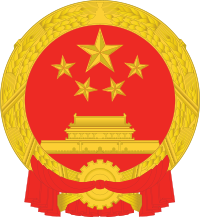
Back شعار الصين Arabic شعار الصين ARZ Emblema nacional de la República Popular China AST Герб Кітая Byelorussian Герб Кітаю BE-X-OLD Герб на Китайската народна република Bulgarian গণচীনর চিনত্হান BPY Grb Kine BS Escut de la República Popular de la Xina Catalan Státní znak Čínské lidové republiky Czech
| National Emblem of the People's Republic of China | |
|---|---|
 | |
| Armiger | People's Republic of China |
| Adopted | 20 September 1950 |
| National Emblem of the People's Republic of China | |||||||||
|---|---|---|---|---|---|---|---|---|---|
| Simplified Chinese | 中华人民共和国国徽 | ||||||||
| Traditional Chinese | 中華人民共和國國徽 | ||||||||
| |||||||||
The National Emblem of the People's Republic of China is a national symbol of the People's Republic of China and contains in a red circle a representation of Tiananmen Gate, the entrance gate to the Forbidden City imperial palace complex, where Mao Zedong declared the foundation of the People's Republic of China (PRC) in 1949. Above this representation are the five stars found on the national flag. The largest star represents the Chinese Communist Party (CCP), while the four smaller stars represent the four revolutionary social classes as defined in Maoism. The emblem is described as being "composed of patterns of the national flag":[1]
...The red color of the flag symbolizes revolution and the yellow color of the stars the golden brilliant rays radiating from the vast red land. The design of four smaller stars surrounding a bigger one signifies the unity of the Chinese people under the leadership of the Communist Party of China (CPC).
—China Yearbook 2004[2]
The outer border of the red circle shows sheaves of wheat and the inner sheaves of rice, which together represent agricultural workers. At the center of the bottom portion of the border is a cog-wheel that represents industrial workers.
According to The Description of the National Emblem of the People's Republic of China (中华人民共和国国徽图案说明), these elements taken together symbolise the revolutionary struggles of the Chinese people since the May Fourth Movement and the coalition of the proletariat which succeeded in founding the People's Republic of China.
- ^ Description of the National Emblem from Chinese Government web portal. Archived 2012-05-02 at the Wayback Machine
- ^ National flag Archived 2007-06-04 at the Wayback Machine